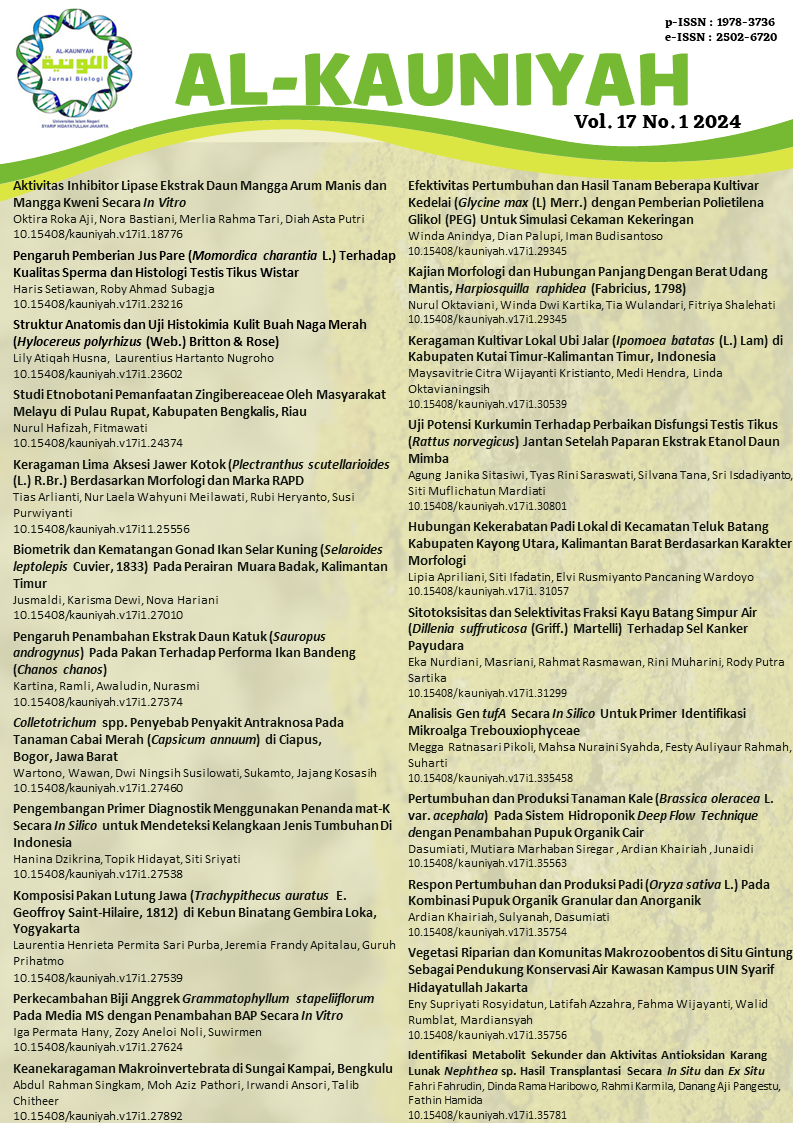Struktur Anatomis dan Uji Histokimia Kulit Buah Naga Merah (Hylocereus polyrhizus (Web.) Britton & Rose)
DOI:
https://doi.org/10.15408/kauniyah.v16i2.1.23602Keywords:
Anatomi, Kulit buah, Metabolit sekunder, Uji histokimia, Anatomy, Histochemical tests, Hylocereus polyrhizus (Web.) Britton & Rose, Peel, Secondary metabolitesAbstract
Abstrak
Kulit buah naga memiliki potensi di berbagai bidang seperti obat-obatan, kosmetik, biopestisida, pewarna, dan perisa pada makanan. Hasil uji fitokimia sebelumnya membuktikan bahwa kulit buah naga merah mengandung senyawa metabolit sekunder. Namun, informasi mengenai struktur anatomis kulit buah naga dari spesies Hylocereus polyrhizus (Web.) Britton & Rose serta analisis histokimianya masih belum ada. Penelitian ini dilakukan bertujuan untuk mengobservasi struktur anatomis kulit buah naga merah dan mengidentifikasi keberadaan serta menganalisis distribusi senyawa fenolik, flavonoid, tanin, alkaloid, dan terpenoid dengan uji histokimia. Metode penelitian terdiri atas pembuatan preparat awetan dengan metode non-embedding dan observasi struktur anatomis kulit buah naga merah, uji histokimia terhadap senyawa fenolik, flavonoid, tanin, alkaloid, dan terpenoid, dan analisis distribusi persebarannya. Hasil penelitian menunjukkan bahwa struktur anatomis kulit buah naga merah terdiri atas bagian eksokarp (jaringan epidermis ganda dengan tipe permukaan cembung pada kulit secara umum dan berpapila pada epidermis atas sisik kulit buah) dan mesokarp (jaringan parenkim air kompak dan non kompak, sel lendir, kristal kalsium oksalat, sklereid, dan trakeid). Adapun senyawa metabolit sekunder yang ditemukan, yaitu fenolik yang terdistribusi pada trakeid, flavonoid pada struktur epidermis, dan alkaloid pada epidermis serta trakeid. Sebaliknya, senyawa tanin dan terpenoid tidak terdeteksi pada kulit buah naga merah.
Abstract
Dragon fruit peel has potential in various fields such as medicine, cosmetics, biopesticides, dyes and food flavors. Previous phytochemical test results proved that red dragon fruit peel contains secondary metabolite compounds. However, information regarding the anatomical structure of dragon fruit peel from the species Hylocereus polyrhizus (Web.) Britton & Rose and its histochemical analysis is still missing. This research was carried out with the aim of observing the anatomical structure of red dragon fruit peel and identifying the presence and analyzing the distribution of phenolic compounds, flavonoids, tannins, alkaloids and terpenoids using histochemical tests. The research method consisted of making preserved preparations using the non-embedding method and observing the anatomical structure of red dragon fruit peel, histochemical tests on phenolic compounds, flavonoids, tannins, alkaloids and terpenoids, and analyzing their distribution. The results of the research show that the anatomical structure of red dragon fruit peel consists of the exocarp (double epidermal tissue with a convex surface type on the peel in general and papillae on the upper epidermis of the fruit peel scales) and the mesocarp (compact and non-compact water parenchyma tissue, mucus cells, crystals calcium oxalate, sclereids and tracheids). The secondary metabolite compounds found were phenolics distributed in tracheids, flavonoids in the structure of the epidermis, and alkaloids in the epidermis and tracheids. In contrast, tannin and terpenoid compounds were not detected in the peel of red dragon fruit.
References
Almeida, O.J.G., de Souza, L.A., Paoli, A.A.S., Davis, A.R., & Sanchez, J.H.C. (2018). Development in fruit epiphytic cacti: implications for fruit classification and macro-morphology in the Cactaceae. Botany, 96(9): 621-635.
Chiocchio, I., Mandrose, M., Tomasi, P., Marincich, L., & Poli, F. (2021). Plant Secondary Metabolites: An Opportunity for Circular Economy. Molecules, 26 (495): 1-31.
Demarco, D. (2017). Histochemical Analysis of Plant Secretory Structures. In: Pelliciari C., Biggiogera M. (eds). Histochemistry of Single Molecules. Methods in Molecular Biology. Vol. 1560. New York, NY: Humana Press.
Evans, W.C. & Trase. (2009). Pharmaognosy (15th ed.). Edinburgh, London, New York, Philadelphia, St. Louis, Sydney, Toronto: Saunders Elsevier.
Franceschi, V.R. & Horner, H.T. (1980). Calcium Oxalate Crystal in Plants. Botanical Review, 46 (4): 361-427.
Gabe, M. (1968). Techniques histologiques. Paris: Masson & Cie.
Ilmiah, H.H., Nuringtyas, T.R., & Nugroho, L.H. (2018). Accumulation of Potential Photo-Protective Compound Groups In Mangrove (Sonneratia cseolaris (L.)Engler.) Leaves. Pharmacogn J., 10(3): 576-580.
Jawa La, E. O., Sawiji, R. T., & Yuliawati, A. N. (2020). Skrining Fitokimia dan Anlisis Kromatografi Lapis Tipis Ekstrak Etanol Kulit Buah Naga Merah (Hylocereus polyrhizus). Indonesian Journal of Pharmacy and Natural Product, 03(01): 2656-3215.
Manihuruk, F. M., Suryati, T., & Arief, I.I. (2017). Effectiveness of the Red Dragon Fruit (Hylocereus polyrhyzus) Peel Extract as the Colorant, Antioxidant, and Antimicrobial on Beef Sausage. Media Perternakan, 40(1): 47-54.
Nugroho, L. H. (2017). Struktur dan Produk Jaringan Sekretorori Tumbuhan. Yogyakarta: UGM Press.
Pagare, S., Bhatia, M., Tripathi, N., Pagare, S., & Bansai, Y. K. (2015). Secondary Metabolites of Plants and Their Role: Overview. Current Trends in Biotechnology and Pharmacy, 9 (3): 2230-7303.
Rahayu, Y. C., Sabir, A. & Setyorini, D. (2019). Antibacterial activity of red dragon fruit extract (Hylocereus polyrhizus) on Streptococcusmutans. International Journal of Applied Pharmaceutics, 11(4): 60-63.
Sutikno. (2016). Buku Panduan Mikroteknik Tumbuhan (BIO 30603). Yogyakarta: Laboratorium Struktur dan Perkembangan Tumbuhan Fakultas Biologi Universitas Gadjah Mada. Yogyakarta.
United Nations. (2019). World Population Prospects 2019. United Nations: New York.

